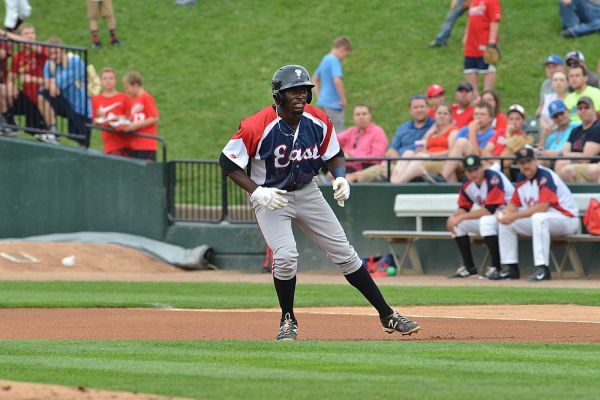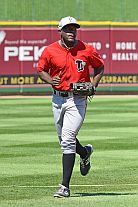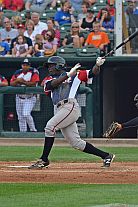Feature Photo: Anthony Alford, OF, Blue Jays (Photo by Paul Gierhart)
“He was at the top of my draft list his senior year of high school,” a scout told me, “even above guys like [Michael] Wacha, [Kevin] Gausman, [Andrew] Heaney and Nick Williams.”
This was my introduction to Anthony Alford, and it sent me to the park this past summer to see the Blue Jays outfielder for the first time with expectations higher than are normally safe for evaluative purposes. Expectations can lead to unwarranted disappointment, which is why it’s generally best not to have too much background information upon a first view of a player. It wasn’t hard to dismiss this introduction as hyperbole anyway, something many scouts are subject to when discussing a player they’re higher on than the general consensus, but it turned out to be frighteningly prophetic.
The rumors of Alford’s athleticism and strong play quickly made their way through scouting circles last season, which often function with the same level of secrecy as a middle school homeroom. A hot first half to begin his first campaign solely committed to baseball, following the forfeiting of his football career, created a unique intrigue, and by mid-season, Alford had forced a promotion to the Florida State League.
Even more interesting from a scouting standpoint than his rare combination of tools and mystery, however, was determining the extent to which his two-sport background should factor in to his assessment, both at present and in future projection. It was impossible not to know about this part of his history, but just how much it should influence his scouting report remained to be seen.
“You have to walk a fine line between using the lack of experience as an excuse for a player’s struggles and identifying the places where it’s a legitimate reason,” another scout told me before seeing Alford. “Poor performance and numbers can’t be automatically dismissed because a player is raw or has been busy playing football, but struggles with specific parts of the game can be expected from a player who has missed significant developmental time.”
Given his football background, an impressive combination of strength, speed and athleticism was to be expected, and Alford did not disappoint. The wild card entering the evaluation process, however, was how those physical abilities would translate into applicable baseball skills. But when the games began, the in-game application of Alford’s skills soon became apparent and impressive.
Approach at the plate – the combination of having a plan of attack against the pitcher, pitch identification, and understanding of the strike zone – is where the transition from gridiron to diamond was expected to be the most difficult, as it’s typically one of the things younger, inexperienced players struggle with the most. It’s also where Alford stood out against his minor league brethren.
“We look for athleticism because those are the tools that are easiest to identify and make for a higher-ceiling player,” said one scout, “but they don’t always translate into hitting ability. That’s where experience typically comes in, which makes what he did this year that much more impressive.”
A “football mentality” typically promotes aggressiveness and assertiveness, two traits that are often positives in the sports world but can be counterintuitive when it comes to effective hitting. Indeed, the most impressive quality of Alford’s game was his ability to channel this aggressiveness at the proper times, like in the field and on the bases, but rein it in at the plate. This won’t necessarily translate into a strong walk rate going forward, as Alford did just as well to get himself into hitter’s counts in plate appearances that didn’t end in walks, but his 13.7 percent walk rate on the season is partially indicative of his ability to stay within himself.
Alford is not without flaws, of course, as no player and certainly no prospect is. His swing is relatively flat, which limits the trajectory on hard hit balls and thus the over-the-fence translation of his power potential. It’s a correctable problem for sure, and one that won’t limit him much even if he doesn’t make an adjustment. Alford’s combination of strength and speed will help him rack up extra-base hits even if he never reaches his full proliferation of power, and his up-the-middle profile and the value added from his legs will require only moderate production from the power department.
None of these are terribly new revelations for scouts who have been tracking Alford since his days as an amateur, and the Blue Jays were wise not to dismiss his foray into football as a lack of commitment to baseball. “Some scouts will ding a player based on ‘baseball commitment’, which is valid,” one final scout told me, “but it’s also a cop out on the scout’s side. If the kid is an athlete and wants to play two sports, I’m fine with it. He’ll eventually fail at one and choose the other. I’ll acknowledge it in my report, but I’m going to reward the kid for wanting to be an athlete.”
There is new information we can glean from Alford’s 2015 season; namely the significant reduction of the risk that accompanied his skill set at this time last year. From a scouting standpoint, factoring in his limited background in the game, it’s important not to let that over-inflate our projections of him going forward. His profile remains largely the same, as a potential top-of-the-order table-setter and center fielder, but after seeing it translate not only into on-field success in 2015, but significant success in a full-season league, Alford now becomes a player the Blue Jays can factor into long-term decision making.




